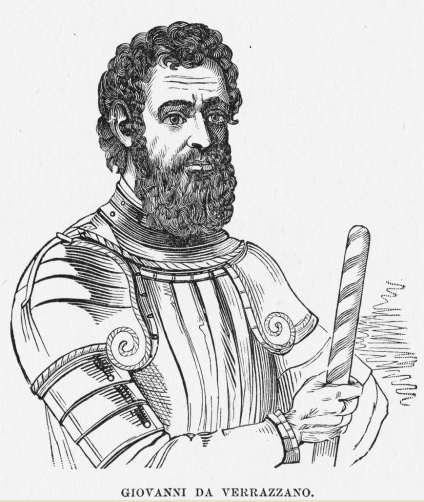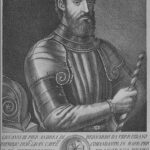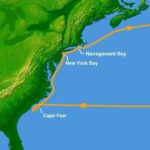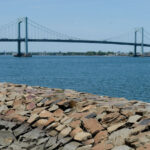Giovanni da Verrazzano
Explorer
Age of Discovery
Quick Facts:
He explored much of the North American east coast from North Carolina up to Maine, and was the first European to reach present day New York
Introduction
Nearly 85 years before Henry Hudson reached present day Hudson Bay in New York, Giovanni da Verrazzano had previously sailed there. Verrazzano voyaged to the New World in search of a passage to Asia. He had sailed along and explored most of the eastern coast of the United States. Once he reached North America, he followed the coast for several months where he encountered numerous native peoples. Some of these natives would be less friendly, and ultimately lead to a grim fate for Verrazzano.
Biography
Early Life
Giovanni da Verrazzano (also spelled Verrazano) was born in 1485. Not much about his early life is known, and the exact location of his birth is unsure. But many historians believe he was born in Tuscany, Italy.1 He was the son of Piero Andrea de Bernardo da Verrazzano and Fiammetta Cappelli. He received a good education in Florence, Italy, and then around 1506, he moved to Dieppe, France. Here, he joined the maritime service, and began his seafaring career as a navigator on French merchant ships in the Mediterranean.2 He made several voyages to the Levant, the land at the eastern end of the Mediterranean Sea.3 Verrazzano would gain the skills needed to command a voyage of his own. During this period, France and Spain were constantly at war with each other. Verrazzano was took part in some privateering, or piracy, against Spanish ships at the French king’s request.
In 1523, Verrazzano was commissioned by King Francis I of France to discover a passage to Asia through the New World. The King of France was interested in finding a direct sea route to the Pacific Ocean. By this time, the Portuguese had a dominance over much of the eastern sea routes to China. The Spanish were exploring and exploiting South America and the Caribbean. Verrazzano suggested to the king that he could find a more direct route to the Pacific by way of a Northwest Passage. The king wanted Verrazzano to explore the eastern coast of the New World from Florida up to Newfoundland to find this route. Verrazzano was financed by a group of French merchants and Italian bankers in Lyons, France. With money and the king’s blessing, Giovanni da Verrazzano sailed from Dieppe, France in late 1523. He started with four ships: La Dauphine, Santa Maria, La Normande, and Vittoria. However, shortly after departing they were caught in a storm.Two ships, the Santa Maria and Vittoria, were lost in the storm. The La Normande was damaged beyond repair, leaving only La Dauphine seaworthy for Verrazzano’s voyage.4
Voyages
Principal Voyage
With one ship, 50 men, and several months worth of supplies, Verrazzano was ready to sail onward. Leaving from the Madeira Islands off the coast of Portugal on January 17, 1524, Verrazzano and his crew officially set sail for the New World. He landed near present day Cape Fear, North Carolina in March 1524. He was met and welcomed by Native Americans who offered him and his crew food.5 He explored further inland and recorded the lush vegetation and landscape of the area before continuing his journey. He sailed south for almost 200 miles, reaching the top of the Florida coast. However, he found no suitable harbor, so he turned around and headed back north to Cape Fear.6 The expedition continued up the coastline in search of passage to Asia. Verrazzano became excited when he encountered a narrow strip of land a large stretch of open water. He was convinced that this large body of water was the South Sea, today known as the Pacific Ocean. He proceeded up the coast expecting at any moment to find a passage that lead to the open sea. However, no such passage existed. What we know today, that Verrazzano did not know then, was that he was in the Pamlico Sound.7 This is a large lagoon off the coast of North Carolina near the Outer Banks.
Verrazzano sailed onward, continuing his search for the Northwest Passage. In mid-April 1524, Verrazzano and his crew became the first known Europeans to sail into New York Bay. Once again they were greeted peacefully by the Native Americans and treated well. He continued sailing along Long Island Sound in New York, and then on to Block Island and Narragansett Bay in present day Rhode Island. He anchored at Newport Harbour spent 15 days exploring the Rhode Island area.8 Verrazzano and his men continued sailing up the coast to Maine where they had a much different experience with the natives. He was not able to explore the coastland because he was driven off by the local Native American tribes. Verrazzano and his crew then sailed up the coast, and stopped in Newfoundland to resupply. They finished their journey here, and headed back to France. They reached Dieppe on July 8, 1524.
Subsequent Voyages
Verrazzano made two more voyages to the New World. In 1527, Verrazzano set out on his second voyage. This time, he commanded a fleet of ships sent on an expedition to South America. Part of his goal was to search for a passage through the continent to the Pacific Ocean.9 He left from Honfleur, France and crossed the Atlantic to South America. He searched and explored parts of the Amazon River, and then along the eastern coast of South America. He entered the Strait of Magellan, but failed to navigate through it. So Verrazzano headed back. Essentially, his trip was unsuccessful. He eventually returned to France, bringing with him profitable dyewood from Brazil.
Later Years and Death
Verrazzano set off on his final voyage in 1528. His brother Girolamo joined Verrazzano on this journey. The expedition left from Dieppe with either two or three ships once again in search of a route to Asia. They sailed to Florida, the Bahamas, and finally the Lesser Antilles – a small group of islands in the Caribbean. He landed on the Caribbean island of Guadeloupe, where he encountered a group of cannibal natives call Caribs. Here, Verrazzano and several of his crew met an unfortunate end when they were captured, killed, and eaten by the Carib natives. While this grim encounter is generally believed to be how Verrazzano was killed, some historians think differently. There are some who think that Giovanni da Verrazzano was a French pirate called Jean Florentine. They believe that he was captured, tried, and hanged as a pirate by the Spanish.10 But this is not confirmed.
Legacy
Giovanni da Verrazzano’s discoveries are often forgotten in comparison to the accomplishments of other explorers. His exploration of the New York area was overshadowed by Henry Hudson almost a century later. And Verrazzano did not find the Northwest Passage to Asia. But he still made great contributions to North American exploration. In his account of his 1524 voyage to the North American continent, and exploration of the coast from Florida to Newfoundland, Verrazzano recorded details unknown to European mapmakers. His discoveries shaped the construction and look of maps that would be used by explorers who came after him. Several bridges in North America bear the explorer’s name. Perhaps the most well-known of these is the Verrazzano-Narrows Bridge which connects Staten Island and Brooklyn in New York. It was once the longest suspension bridge in the world, and commemorates the achievements of Giovanni da Verrazzano.
Images
- Portrait of Giovanni da Verrazzano {{PD-Art}}
- Verrazzano’s Map of Voyage (Credit: NASA)
- Verrazzano-Narrows Bridge in New York (Credit: nycgovparks.org)
Endnotes
- Michael Anderson, ed., Biographies of the New World: Leif Eriksson, Henry Hudson, Charles Darwin, and More, (New York: Britannica Educational Publishing, 2013), 43.
- Melvin E. Page, ed., Colonialism: An International Social, Cultural, and Political Encyclopedia, Volume 1 (Santa Barbara: ABC-CLIO, 2003), 610.
- Anderson, Biographies of the New World, 43.
- Paul R. Wonning, “July 08, 1524,” Colonial American History Stories – 1215 – 1664: Forgotten and Famous Historical Events, (Mossy Feet Books: 2017).
- Marshall Cavendish Corporation, Explorers and Exploration, Volume 10 (New York: Marshall Cavendish, 2005), 767.
- Alan Day, Historical Dictionary of the Discovery and Exploration of the Northwest Passage (Lanham: The Scarecrow Press, Inc., 2006), 285.
- Day, Historical Dictionary, 285.
- Rocky M. Mirza, The Rise and Fall of the American Empire: A Re-Interpretation of History, Economics and Philosophy: 1492-2006 (British Columbia: Trafford Publishing, 2007), 58.
- Wonning, Colonial American History Stories, “The First Attempt”.
- Seymour I. Schwartz, The Mismapping of America (Rochester: University of Rochester Press, 2003), 40.




